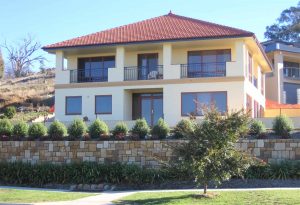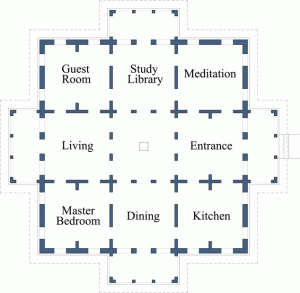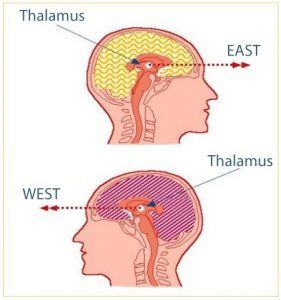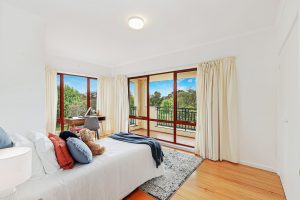Although the ancient knowledge of Vedic architecture is closely related to that of Ayurveda, it is still relatively unknown in the West. The ancient traditions of the Veda are divided into 40 areas of life, and one of these includes architecture and urban planning.
The Sanskrit word ‘Sthapan’ means to create or establish. The word ‘Veda’ means knowledge in the sense of knowledge of natural law. Thus, ‘Sthapatya Veda’ is the knowledge necessary to create anything in harmony with the cosmic order. When applied to architecture, it is often called ‘Vastu Vidya’ (the science of building) or ‘Vastu architecture’.
Maharishi Mahesh Yogi, known as the founder of Transcendental Meditation, has revived the ancient Vedic traditions and made them available to modern man. In this context, also the forgotten knowledge of Vedic Architecture was rediscovered and reinterpreted.
By now, it is recognized worldwide and is gaining popularity. For example, an international consultancy service for Vedic Architecture has been established at Maharishi University in the Netherlands and provides advice worldwide on building projects according to Vedic principles. Architects who have received thorough additional training in Maharishi Sthapatya Veda can be referred from there.
© Maharishi Vedic University – www.maharishivastu.org.au/portfolio/nicholls/
Building fortune-creating houses
A building constructed according to the principles of Sthapatya Veda should bring spiritual and material well-being to its occupants by generating only life-supporting influences. This is because Vastu architecture allows us to incorporate in a building the same cosmic laws that keep the universe perfectly organized.
As human beings, we are constantly receiving influences and energies from everywhere, including from the Sun, the Moon, and the Earth itself. We live in electric, magnetic, and thermal fields, which are modified by the construction of houses.
Thus, every room resonates with these energies in its own way and in turn affects our physiology. If the frequencies are balanced, we feel comfortable and energetic there. If, on the other hand, there are disharmonious influences, our well-being is hampered, which can result in irritation, sleep disturbances and restlessness, to name just a few examples.
By taking into account the laws of nature and the principles of Vastu architecture, we can enhance the right qualities in the right place, such as better concentration in the office, healthy sleep in the bedroom, and relaxation in the living room.
To maximize the quality of life in a Vastu home, the following points should be considered during construction:
- Selection of an ideal plot of land
- Orientation and entrance of the building towards the east
- Establishing a Brahmasthan, a resting point, in a central place of the house
- Proper location and proportions of the rooms
- Selection of suitable building materials.
© 1998 MFI, Maharishi Foundation International, the Netherlands.
® Transcendental Meditation and Maharishi Sthapatya Veda
are registered or common law trademarks of Maharishi Foundation International
The Power of the East
Why does Vedic architecture consider it so important to orient the house towards the east?
The cardinal direction east plays a central role in many cultures, because it’s in the east that the Sun rises, the provider of the rhythm and energy for our lives.
For example, in most churches, the altars and choirs are aligned so that visitors face east during the service.
And in Western as well as Vedic astrology, horoscopes are calculated based on which planets and constellations were rising in the east at the time of birth.
More recently, research has discovered that our brain works differently when we look to the east. Certain neurons in the hypothalamus react to our spatial orientation and are particularly strongly stimulated when we look toward the east, which is also the direction of rotation of our Earth. Therefore, Sthapatya Veda recommends orienting the head end of the bed as well as the writing desk to the east. If a house is newly built, it is also very beneficial to put the entrance in the east.
© 1998 MFI, Maharishi Foundation International, the Netherlands.
® Transcendental Meditation and Maharishi Sthapatya Veda
are registered or common law trademarks of Maharishi Foundation International
Influence of the cardinal directions on health and vitality
In Vastu architecture, the positioning of the rooms and the building as a whole plays an immensely important role. The aim is to harmonize the house or apartment with the surrounding nature and to establish a favorable connection to the energies of the Earth and the Sun, thus not only increasing our well-being and productivity, but also optimally supporting us in our material and spiritual development.
The recommendations are based on the Earth’s magnetic field and the light conditions during the day, which have been shown to permanently influence our well-being. When we live in accord with the course of the sun, we feel most comfortable. That is why it is recommended to sleep with the head towards the east and – ideally – to be awakened by the rising sun. Having the entrance to the house or apartment in the east not only supports the early morning creative energy on the way to work, but also has a harmonizing influence on those who live there, every time they enter or leave the house.
Arrangement of the rooms
The kitchen is best placed in the southeast, which corresponds to the position of the sun during the late morning. The dining room is located in the south, the cardinal direction where the sun is highest. Ayurveda knows that this strong influx of light optimally activates our digestive power. This is also the reason why the main meal should be taken around noon: at that time, our inner fire, called Agni, is at its strongest, so even a larger meal can be digested well.
In the afternoon and evening, family life becomes more prominent and life takes place in the living room. In the Vedic building diagram, this is located in the west, where the sun sets and provides a more calming light.
This is the ideal arrangement, which takes into account the different energy qualities of the Sun over the course of the day and supports our biorhythm. Preliminary studies have confirmed the influence of a building’s orientation on health and well-being.
© 1998 MFI, Maharishi Foundation International, the Netherlands.
® Transcendental Meditation and Maharishi Sthapatya Veda
are registered or common law trademarks of Maharishi Foundation International
Sleep better with Sthapatya Veda
Rearranging or even renovating one’s house or apartment to bring it in line with the above-mentioned principles may be a difficult task. However, what is relatively easy to do and can already significantly improve your quality of life is setting up a suitable sleeping place.
Ayurveda emphasizes the importance of sleep as a time of regeneration and detoxification, and we can decisively influence it by adjusting our daily routine and our bedroom. During an Ayurvedic consultation, it is not uncommon for the Vaidya to ask, which direction your bed is facing.
Ayurveda emphasizes the importance of sleep as a time of regeneration and detoxification, and in addition to having a suitable daily routine, we can also decisively influence it by adjusting our bedroom. During an Ayurvedic consultation, it is not uncommon for the Vaidya to ask in which direction your bed is facing.
So what influence do the different cardinal directions have on our sleep?
The most favorable orientation is having the head of the bed in the east, because then we are aligned with the earth’s rotation and our body’s own magnetic field is charged. This also makes best use of the qualities of the rising sun.
The second-best option is to sleep with the head towards the south, because in this position the body is in alignment with the Earth’s magnetic field lines.
It can be very unfavorable to sleep with the head towards the north or west: in this position, sleep tends to be light and restless, or disturbed by nightmares. As a result, you may feel a lack of energy and more fatigue during the day.
© Maharishi Vedic University – www.maharishivastu.org.au/portfolio/nicholls/
The sleeping area should be kept free of electronics such as tv or smartphone. The ideal place for the bed is in the southwest of the room, with the head facing east. It is recommended not to have the bed right in the middle of the room, nor should it be placed completely against a wall. The guidelines say it should be 10–20 cm away from the wall and – this is something everyone does automatically – parallel to the walls.
The bed should be made of solid wood. We particularly advise against water beds, which lead to electromagnetic pollution and restless sleep due to the heating of the water. Pillows, comforters and bed linen should all be made of natural materials, as these do not pick up electrostatic charge, unlike synthetic fibers. In terms of color, it’s clear that hues and tones in a bedroom should have a soothing and balancing effect.
On the whole, the bedroom should be orderly and uncluttered, without too many things in it, because a deep, restful sleep requires that Vata and Pitta Doshas are balanced and that a gentle Kapha can unfold.
Vata is generally stimulated – or overstimulated – by everything that is agitated, i.e. also by restless patterns, as well as by dark shades such as black, dark blue, and brown. Pitta, on the other hand, is activated by reds and bright colors, as well as by intense, invigorating patterns. A balanced, gentle Kapha can be established by pastel tones and whites, and by large areas of one color, creating a feeling of stillness – somewhat like the calming effect of gazing at a lake.
© Maharishi Vedic University – www.maharishivastu.org.au/portfolio/nicholls/
To best cater for all three Doshas, preference should be given to light, delicate colors with little or no patterning in the choice of wall colors and bedding – remember the quiet whites of the traditional bedding used by our grandparents in the past? It may have been a bit monotonous (literally!), but from an Ayurvedic point of view it was perfect for promoting sound sleep.
We invite you to have a look at your bedrooms’ setup through the eyes of Vastu architecture and see which adjustments, small or big, you could make to enhance the restorative and balancing effect of your sleep.
Your Maharishi Ayurveda Team from Bad Ems
You can find more information about Vedic Building and Living here:
Research on Maharishi Vastu Architecture
Download the article as a PDF file
© Maharishi Ayurveda Health Centre Bad Ems






Very good information with Vedic & scientific reasoning.
Thank you Maharshi Ayurveda Team.